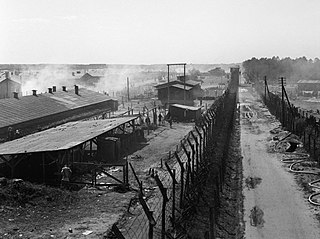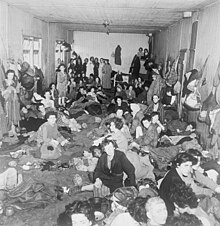
Bergen-Belsen, or Belsen, was a Nazi concentration camp in what is today Lower Saxony in northern Germany, southwest of the town of Bergen near Celle. Originally established as a prisoner of war camp, in 1943, parts of it became a concentration camp. Initially this was an "exchange camp", where Jewish hostages were held with the intention of exchanging them for German prisoners of war held overseas. The camp was later expanded to hold Jews from other concentration camps.

Josef Kramer was Hauptsturmführer and the Commandant of Auschwitz-Birkenau and of the Bergen-Belsen concentration camp. Dubbed the Beast of Belsen by camp inmates, he was a German Nazi war criminal, directly responsible for the deaths of thousands of people. He was detained by the British Army after the Second World War, convicted of war crimes, and hanged on the gallows in the prison at Hamelin by British executioner Albert Pierrepoint.

Bergen-Belsen displaced persons camp was a displaced persons (DP) camp for refugees after World War II, in Lower Saxony in northwestern Germany, southwest of the town of Bergen near Celle. It was in operation from the summer of 1945 until September 1950. For a time, Belsen DP camp was the largest Jewish DP camp in Germany and the only one in the British occupation zone with an exclusively Jewish population. The camp was under British authority and overseen by the United Nations Relief and Rehabilitation Administration (UNRRA) with camp directors that included Simon Bloomberg. Today, the camp is a Bundeswehr barracks, having been a British Army base until 2015.
Nathaniel Thomas Allen Fiennes, 21st Baron Saye and Sele,, styled as Lord Saye and Sele, is an English peer, businessman, former chartered surveyor, and retired British Army officer.
The Relief of Belsen is a feature-length drama that was first shown on Channel 4 in the United Kingdom on 15 October 2007. It depicts events that unfolded at Bergen-Belsen concentration camp following the liberation of the camp by British troops in April 1945. Written by Justin Hardy and Peter Guinness, it nevertheless cites its sources from eyewitness accounts of people who were there at the time. These accounts are referred to throughout the film. It was directed by Justin Hardy, and produced in association with the Wellcome Trust.
Major-General James Alexander Deans Johnston, was a senior British Army officer in the Royal Army Medical Corps and the Senior Medical Officer at the liberated Bergen-Belsen concentration camp towards the end of the Second World War. A docudrama portraying his experiences attempting to save the starving and diseased concentration camp prisoners at Bergen-Belsen was made in 2007 entitled The Relief of Belsen.
Arnold Peter Meiklejohn was an English physician and academic, specializing in nutrition.
Alexander Paton was a British gastroenterologist, writer and postgraduate dean for North-West London hospitals, who was a specialist in alcohol misuse.

In early April 1945, at the request of the British Army, the British Red Cross and the War Office called for 100 volunteer medical students from nine London teaching hospitals to assist in feeding starving Dutch children who had been liberated from German occupation by advancing Allied forces. However, in the meantime, British troops had liberated Bergen-Belsen concentration camp and the students were diverted there on the day they were due to travel to the Netherlands. The students had previously spent most of the Second World War at school and in medical training.
John Brian Walker was a British general practitioner with a prior career in eye surgery. After studying at New College, Oxford and while studying medicine at The London Hospital in 1945, he was one of the London medical students who were sent to Bergen-Belsen concentration camp shortly after its liberation by British troops, to assist in the feeding of the severely malnourished and dying inmates, under the supervision of nutritionist Arnold Peter Meiklejohn. After gaining his medical degree, he was drafted into the army and sent to east Africa, where he became an eye surgeon. Following demobilisation, he returned to London with his wife Mary and took on his father's general practice. Walker was also known for his skill in sailing with the Hornet dinghy fleet throughout the 1950s to 1970s.

Michael John Hargrave was a British general practitioner in Wootton Bassett, Wiltshire, who in 1945 assisted British Army occupation forces at the recently-liberated Bergen-Belsen concentration camp when he volunteered as a medical student from Westminster Hospital at the age of 21.

Sidney Clifford Brookfield Yorke (1922–2007), was a British Psychiatrist at the Maudsley Hospital who in 1945 while studying medicine at King's College Hospital, assisted at Bergen-Belsen concentration camp as a voluntary medical student. He took over from Anna Freud at the Hamstead Clinic.

Dennis Henry Forsdick, was a British physician at the Friarsgate Medical Centre. In 1945, while studying medicine at Guy's Hospital, he assisted at Bergen-Belsen concentration camp as a voluntary medical student.

John Langford Hayward, was a British breast surgeon who researched treatment for advanced breast cancer. In 1945, while studying medicine at Guy's Hospital, he assisted with the Relief effort at Bergen-Belsen concentration camp as a voluntary medical student. He graduated in 1947.

Michael Gwynne Douglas Davys, was a British psychiatrist in Harrow on the Hill, who specialised in depression in children. In 1945, while studying medicine at Guy's Hospital, he assisted at Bergen-Belsen concentration camp as a voluntary medical student.

David Sells Hurwood was a British general practitioner in Syston and founder member of the Royal College of General Practitioners. In 1945, while studying medicine at Guy's Hospital, he assisted at Bergen-Belsen concentration camp as a voluntary medical student. Here, he developed tuberculosis.

Daniel Oliver Davies, also known as Dan Davies, was a British general practitioner who co-founded a health centre in Whitstable, established a general practitioner course in Canterbury, was secretary of the East Kent Division of the British Medical Association and served with the Zambia Flying Doctor Service. In 1945, while studying medicine at Guy's Hospital, he assisted at Bergen-Belsen concentration camp as a voluntary medical student.
Alan David Rowan MacAuslan, was a British doctor who in 1945, while studying at St Thomas' Hospital, assisted at Bergen-Belsen concentration camp when he volunteered as a medical student. In 2005, at the age of 83, his story was reported in the BBC News.
Peter William Gedge Tasker was a British general practitioner who performed some of the earliest studies of the causes of anaemia using radioactive tracer techniques. During his studies at The London Hospital in 1945, he was one of the London medical students who were sent to Bergen-Belsen concentration camp shortly after its liberation by British troops, to assist in the feeding of the severely malnourished and dying inmates, under the supervision of nutritionist Arnold Peter Meiklejohn. During the Malayan Emergency, he assisted by taking on the role as a pilot.











